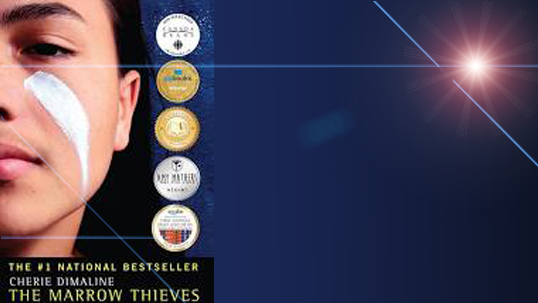Author: Cherie Dimaline

“The Marrow Thieves,” by Cherie Dimaline, is a young adult novel that is set in an apocalyptic dystopian future where Canada has been so damaged by global warming that everyone has been impacted by the consequences. The water level is rising, continents are being fully submerged, and everyone is forced to migrate in order to survive. As a result, the majority of the population has lost the ability to dream, and are now experiencing severe psychological distress, which makes them difficult to govern. The only people who still have the ability to dream are Indigenous people. It is explained that “dreams get caught in the webs woven in [their] bones. That’s where they live, in that marrow there” (Dimaline, 2017, p. 20). Therefore, the Canadian government has deployed “Recruiters” (aka the “marrow thieves”) to find and capture Indigenous people so that they can extract their bone marrow and use it to find a cure or treatment for people who can no longer dream. They believe that this is the only way to help salvage the rest of humanity before everyone else loses their minds, and they descend into further chaos.
The fast-paced story is told from the perspective of a fifteen-year old Indigenous boy named Frenchie, who is on the run from Recruiters, and is separated from his brother, Mitch. On his journey, he meets another diverse group of Indigenous survivors, who temporarily adopt him into their family in order to travel together safely. He soon realizes that these people, particularly members of the younger generation, have a very different connection to their “roots” than he does. Through Frenchie’s experiences, ideas about family, belonging, storytelling, and Indigenous ways of knowing are explored.
The author, Cherie Dimaline, is a Canadian Indigenous writer, who is part of the Georgian Bay Métis community in Ontario. This is her first young adult novel, which has won several awards, been the number one national bestseller, and has gained much critical acclaim since its publication in 2017. Through her speculative fiction, the author alludes to many current real-world problems and events that have happened in the course of Canadian history. For example, showing the potentially disastrous effects of the current climate crisis, and the intergenerational trauma inflicted on Indigenous people, particularly by the Residential school system. In an interview, Dimaline talked about how her writing mimics a traditional Indigenous way of storytelling, where each character is given a backstory when introduced, and then situated in the current context (Paikin, 2018). The narrative is mostly written in linear, chronological order, but includes flashbacks where necessary and relevant. It is clear that Dimaline values language and chooses her words carefully, to evoke vivid imagery, and draw clear metaphors.
When examining the text through the lens of representations of teaching and learning, there are several levels of education happening simultaneously. First, there is Frenchie’s journey of learning about his family’s “roots,” traditions, and history, which is tied to Indigenous ways of storytelling. This helps him construct his own identity, which is then challenged and re-shaped by Miigwans and his teachings. There is a heavy emphasis on Story (with a capital “S”) being a sacred event that helps Indigenous youth learn and grow by being bestowed with particular knowledge at specific times in their lives, and having the responsibility of passing on those stories to others when they come of age. Second, there is an interrogation of the way the Canadian government, specifically via Recruiters, who are trying to access knowledge (or a cure for the dreamless) by harvesting it from the bodies of Indigenous people. The fact that these horrific acts and injustices take place in “schools,” which are usually positive places of research and discovery, alludes to the corruption around seeking and gaining knowledge at the expense of marginalized groups. Finally, the reader is educated about Indigenous histories, the power of storytelling and language, and how to approach difficult ideas or knowledge, with an open mind and heart, to protect the hopes and dreams of those in future generations. Overall, this is a powerful text that uses the theme of education to help facilitate discourse about history, and the conciliation with Indigenous communities. At its core, this is an inspiring and emotional story about survival, the strength of familial roots, and hope.
References
Dimaline, C. (2017). The Marrow Thieves. Cormorant Books Incorporated.
Paikin, S. (2018, August 22). The Agenda In the Summer: Cherie Dimaline- Reclaiming Lost
Dreams. TVO.
The review goes here
